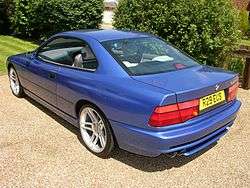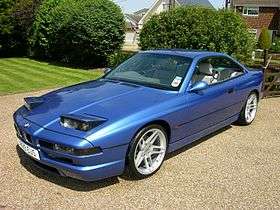BMW 8 Series (E31)
| BMW 8 Series (E31) | |
|---|---|
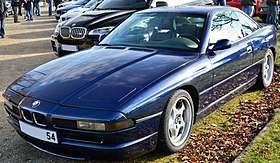 BMW 850 CSi | |
| Overview | |
| Manufacturer | BMW |
| Production |
May 1989[1]–May 1999 30,621 built[2] |
| Assembly | Germany: Dingolfing[3] |
| Designer | Klaus Kapitza (1986)[4] |
| Body and chassis | |
| Class | Grand tourer |
| Body style | 2-door coupé |
| Layout | Front-engine, rear-wheel-drive |
| Powertrain | |
| Engine |
4.0 L M60B40 V8 4.4 L M62B44 V8 5.0 L M70B50 V12 5.4 L M73B54 V12 5.6 L S70B56 V12 |
| Transmission |
4-speed automatic 5-speed automatic 6-speed manual |
| Dimensions | |
| Wheelbase | 2,685 mm (105.7 in)[5] |
| Length | 4,780 mm (188 in) |
| Width | 1,854 mm (73.0 in) |
| Height | 1,341 mm (52.8 in) |
| Chronology | |
| Successor | BMW 8 Series (G15) |
The BMW E31 is the first generation of the BMW 8 Series. It is a grand tourer built by BMW from 1989 to 1999 powered by either a V8 or V12 engine. While it did supplant the original E24 based 6 Series in 1991, a common misconception is that the 8 Series was developed as a successor. It was actually in an entirely new model class aimed at a different market, with a substantially higher price and performance than the 6 Series.
Development
.jpg)
Development of the 8 Series began in July 1981, with both the final design phase reaching completion and production development starting in 1986. The 8 Series debuted at the Frankfurt Motor Show (IAA) in early September 1989. The 8 Series was designed to move beyond the market of the original 6 Series. The 8 Series had substantially improved performance, as well as a far higher purchase price.
Over 1.5 billion Deutsche Mark was spent on total development (2008 USD nearly $1 billion). BMW used CAD tools, still unusual at the time, to design the car's all-new body. Combined with wind tunnel testing, the resulting car had a drag coefficient of 0.29, a major improvement from the previous BMW M6/635CSi's 0.39.
The 8 Series offered the first V12 engine mated to a 6-speed manual transmission on a road car. It was one of the first vehicles to be fitted with an electronic drive-by-wire throttle. The 8 Series was one of BMW's first cars, together with the Z1, to use a multi-link rear axle.
While CAD modeling allowed the car's unibody to be 8 lb (3 kg) lighter than that of its predecessor, the car was significantly heavier when completed due to the large engine and added luxury items—a source of criticism from those who wanted BMW to concentrate on the driving experience. Some of the car's weight may have been due to its pillar-less "hardtop" body style, which lacked a "B" post.
Sales of the 8 Series were affected by the global recession of the early 1990s, the Persian Gulf War, and energy price spikes. As a result, plans for the high performance M8 variant were dropped in 1991.
BMW pulled the 8 Series from the North American market in 1997, having sold only 7,232 cars over a seven year period. BMW continued production for Europe until 1999. The ultimate worldwide production total was 31,062.[2][6] The base price for an entry-level 8 series in the early 1990s started in the US$70,000 range, which is US$131,121 in 2017.[7] [8]
Production models
840Ci
The 840Ci exists with two different engine packages. The first used the 4.0 litre M60B40 V8 engine with 286 PS (210 kW; 282 hp) and was produced from mid-1993 to late 1995. From mid-1995, production phased in the newer 4.4 litre M62B44 V8 engine, which had better fuel economy and more torque, though power output remained unchanged.
The 840Ci was available with a 5-speed automatic transmission, though European cars were given the option of a 6-speed manual transmission. The only external features distinguishing the V8 model from the V12 models were the quad round exhausts, which were square in the V12 models. The 840Ci stayed in production until May 1999.
850i
_coupe_01.jpg)
This was the first model launched in 1990 with the 5.0 litre M70B50 V12 engine producing 300 PS (221 kW; 296 hp). It was available with either a 4-speed automatic or a 6-speed manual gearbox.
850Ci
.jpg)
There is some confusion over why and when the 850i became the 850Ci. The change happened around the introduction of the 850CSi and it is believed that BMW decided to include the "C" in the model name that denotes 'Coupe', just as two-door 3 Series cars alongside the 8 Series read 323Ci, 328Ci and so on. The confusion started when BMW installed the new M73B54 V12 engine in the car. This was not an immediate changeover, and indeed both the M70 and M73-engined cars rolled off the production lines side-by-side for about nine months in 1994, both named 850Ci.
As the displacement of the M73 increased to 5.4 litres and the compression ratio went up, the power output increased to 326 PS (240 kW; 322 hp).
850CSi
As a top-of-the-range variant of the 8 Series, the 850CSi took over from the prototype M8 variant. The 850CSi used the same engine as the 850i, which was tuned so significantly that BMW assigned it a new engine code: BMW S70B56. The modifications included Bosch Motronic 1.7 fuel injection, a capacity increase to 5,576 cc (5.6 L) and power increase to 380 PS (375 bhp; 279 kW) at 5,300 rpm and 550 N⋅m (406 lbf⋅ft) of torque at 4,000 rpm.[9]
The 850CSi's modified suspension included, stiffer springs and dampers that reduced the car's ride height. The recirculating ball steering ratio was dropped 15% over the stock E31 setup. The model also sported staggered throwing star wheels. The front and rear bumpers were reshaped for improved aerodynamic performance. Four round stainless steel exhaust tips replaced the square tips found on other models. The 6-speed manual gearbox was the only transmission option. In Europe, all 850CSi's came with four-wheel steering (AHK - Aktive Hinterachs-Kinematik, Active rear axle Kinematics), uprated and ventilated brakes with floating front discs, rear differential oil cooler, engine oil cooler, two-tone interior, sports seats, and reshaped mirrors. In the United States, the cars instead received "BMW Motorsport" writing on the doorhandles.
Production ended in late 1996 because the S70 engine could not be modified to comply with new emission regulations without substantial re-engineering.
.jpg)
.jpg)
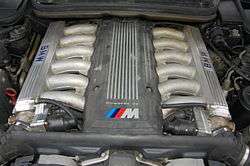
Powertrain and production data
Engines
| Model | Years[2] | Engine code | Power | Torque | Production total[2] |
|---|---|---|---|---|---|
| 840Ci | 1992–96 | M60B40 | 210 kW (286 PS; 282 hp) | 400 N⋅m (300 lb⋅ft) | 4,728 |
| 840Ci | 1995–99 | M62B44 | 210 kW (286 PS; 282 hp) | 420 N⋅m (310 lb⋅ft) | 3,075 |
| 850i | 1990–94 | M70B50 | 221 kW (300 PS; 296 hp) | 450 N⋅m (330 lb⋅ft) | 20,072 |
| 850Ci | 1992–99 | M73B54 | 240 kW (326 PS; 322 hp) | 490 N⋅m (360 lb⋅ft) | 1,218 |
| 850CSi | 1992–96 | S70B56 | 280 kW (381 PS; 375 hp) | 550 N⋅m (410 lb⋅ft) | 1,510 |
Transmission

The 840Ci (4.0/4.4l V8) models were equipped with a 5-speed automatic transmission or a 6-speed manual transmission. The 850i/850Ci (V12) models each carry either a 4-speed automatic transmission or a 6-speed manual transmission, a 5-speed automatic transmission was fitted from mid-1994. The 850CSi model only came with a 6-speed manual transmission.
Fuel economy
1997 United States Environmental Protection Agency estimates for cars equipped with automatic transmission.
840Ci[10]
- Fuel type: Premium
- city: 15 miles per US gallon (16 L/100 km; 18 mpg‑imp)
- highway: 20 miles per US gallon (12 L/100 km; 24 mpg‑imp)
- combined: 17 miles per US gallon (14 L/100 km; 20 mpg‑imp)
850Ci[11]
- Fuel type: Premium
- city: 14 miles per US gallon (17 L/100 km; 17 mpg‑imp)
- highway: 20 miles per US gallon (12 L/100 km; 24 mpg‑imp)
- combined: 16 miles per US gallon (15 L/100 km; 19 mpg‑imp)
For the 850i, 1991 Sport Model specifically the On-Board computer will typically read 24.6L/100 km when the car is often used under heavy acceleration. These figures could be similar if not slightly less/more for more newer versions of the 850i Sport.
Prototype models
830i
The 830i was a prototype that did not reach production.[12][13] As the potential entry-level model, the 830i was to use the 3-liter V8 with 218 PS (160 kW; 215 hp) from the 530i and 730i, known internally as the M60B30. Eighteen cars were produced, thirteen of which had an automatic gearbox fitted.[14] The model was dropped in favour of the 840Ci and almost all of the 18 cars were dismantled; one car is in a BMW museum.
850i Cabrio
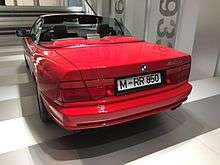
The 8 Series had been planned from the start with a convertible version in mind. Although the 850i Cabrio was developed to production readiness, it never went into production. At a relatively late date it was decided that this model was unlikely to recover its development cost. A prototype in red resides in the BMW Museum in Munich.
M8
Originally envisioned as a Ferrari competitor equipped with a special 550 bhp (410 kW; 558 PS) version of the S70 engine, essentially a bored out version of the M70 with 4-valve per cylinder heads. A common misconception is that this engine powered the McLaren F1. The S70/2 used in the McLaren F1 was not based directly on the prototype 4-valve V12 used in the M8, and was a completely new design.[15]
The project was eventually scrapped because BMW decided that there was no market for an M8 primarily because of the recession of the 1990s. The only prototype ever produced (one that was reportedly not even safe for normal road usage) was locked away by BMW in the company's Giftschrank (poison storage).[16] BMW and the M Division had strongly denied that the car was even a possibility since the initial stages of its development. A world exclusive feature in the February 2010 issue of BMW Car Magazine, however, revealed that the M8 prototype still exists in its entirety.[17] The car was unveiled to journalists for the first time on July 2, 2010 at the BMW Museum in Munich.[18] The only public showing of the car happened on August 17, 2012 during 'The Legends of the Autobahn' car show held in Carmel, California.[19] The car was specially shipped from Germany for the appearance.
Although the M8 was never produced, the 850CSi was also tuned by BMW's M division. Aside from sporting an M-tuned engine (as identified by the S prefix instead of the M prefix that a non-M tuned engine would bear), the car's VIN identifies the car as being built by BMW Motorsport (a WBS prefix) instead of BMW AG (WBA prefix). Per BMW's own protocol, the 850CSi as marketed was essentially a de-tuned version of the putative M8.[20]
Alpina models
B12 5.0
The B12 5.0 was built from 1990 to 1994 based on the BMW E31 850i with an Alpina modified BMW M70 V12 (shared with the E32 B12 5.0) producing 350 PS (257 kW; 345 hp) mated to an automatic transmission.
B12 5.7
The B12 5.7 was available from 1992, based on the BMW 850CSi with the BMW S70B56 V12 engine bored out to 5.7 litres along with a modified intake, crankshaft, camshafts and a stainless steel exhaust system as well as a 6-speed manual gearbox. The modified engine produced 418 PS (307 kW; 412 hp). The carbon-fibre hood had cooling vents and a NACA duct for improved engine cooling. Performance figures included a 0–60 mph (0–97 km/h) acceleration time of 5.8 seconds and a top speed of 186 mph (299 km/h).[21]
.jpg)
.jpg)
.jpg)
Motorsport
The 8 Series is a very rare car to see in any form of motorsport. One of the most successful examples was built by Wagenstetter Motorsport[22] however, and, until recently, was raced in the Nurburgring VLN endurance championship. It’s based on an 840i, but now has an E39 M5 5.0-litre V8, which has 555 bhp (414 kW; 563 PS) and 472 lb⋅ft (640 N⋅m) torque, and a six-speed gearbox from the same car.
References
- ↑ https://www.e31.net/development.html
- 1 2 3 4 "Models overview @". E31.net. Retrieved 2010-12-05.
- ↑ "Dingolfing Plant History". www.bmwgroup-plants.com. BMW AG. Retrieved 24 December 2017.
- ↑ Caspers, Markus (2017). Designing Motion: Automotive Designers 1890 to 1990. Birkhäuser. p. 122. ISBN 9783035607840. Retrieved 18 June 2018.
- ↑ "BMW 840 @ carfolio". Carfolio.com. 2008-08-22. Retrieved 2010-12-05.
- ↑ "Shipments by country @". E31.net. Retrieved 2010-12-05.
- ↑ Federal Reserve Bank of Minneapolis Community Development Project. "Consumer Price Index (estimate) 1800–". Federal Reserve Bank of Minneapolis. Retrieved January 2, 2018.
- ↑ Consumer Price Index (estimate) 1800-2012. Federal Reserve Bank of Minneapolis. Retrieved 2012-10-28.
- ↑ "1992 BMW 850 CSi E31". carfolio.com. February 28, 2013. Retrieved June 12, 2018.
- ↑ "US EPA Ratings for 1997 BMW 840Ci automatic". Fueleconomy.gov. Retrieved 20 August 2017.
- ↑ "US EPA Ratings for 1997 BMW 850Ci automatic". Fueleconomy.gov. Retrieved 20 August 2017.
- ↑ "www.e31.net". www.e31.net. Retrieved 2014-06-22.
- ↑ "Review: BMW 8 Series". Bmwblog.com. 2011-12-26. Retrieved 2014-06-22.
- ↑ "BMW 8 Series - Vin/Chassis Information". 8Coupe.com. Retrieved 10 March 2017.
- ↑ "BMW Classic - Recherche-Client". bmw-grouparchiv.de. Retrieved 28 February 2018.
- ↑ "BMW M8, Unrivaled and Unveiled". BMWblog. 13 September 2010. Retrieved 16 June 2018.
- ↑ "Issue 188 Of BMW Car Magazine". Bmwcarmagazine.com. Archived from the original on 13 February 2010. Retrieved 20 August 2017.
- ↑ "Exclusive Photos: BMW M8". Bmwblog.com. 2010-07-03. Retrieved 2010-07-07.
- ↑ "BMW Bringing M8 Prototype and Zagato Coupe Study to The Legends of the Autobahn". CarScoops. Retrieved 5 September 2013.
- ↑ "850CSi @". E31.net. Retrieved 2010-12-05.
- ↑ "Extremely Low Mileage Alpina B12 5.7 Is Extremely Expensive". BMWblog. 21 November 2017. Retrieved 16 June 2018.
- ↑ "Motorsport's rare BMW's; M5, 6-Series and 8-Series". germancarmagazine.com. Archived from the original on 16 February 2009. Retrieved 2009-02-14.
External links
| Wikimedia Commons has media related to BMW E31. |
« previous — BMW cars: 1980s to 2000s — next » | |||||||||||||||||||||||||||||||||||
|---|---|---|---|---|---|---|---|---|---|---|---|---|---|---|---|---|---|---|---|---|---|---|---|---|---|---|---|---|---|---|---|---|---|---|---|
| Series | 1980s | 1990s | 2000s | ||||||||||||||||||||||||||||||||
| 0 | 1 | 2 | 3 | 4 | 5 | 6 | 7 | 8 | 9 | 0 | 1 | 2 | 3 | 4 | 5 | 6 | 7 | 8 | 9 | 0 | 1 | 2 | 3 | 4 | 5 | 6 | 7 | 8 | 9 | ||||||
| 1 Series | E87>> | ||||||||||||||||||||||||||||||||||
| 3 Series | <<E21 | E30 | E36 | E46 | E90>> | ||||||||||||||||||||||||||||||
| 5 Series | <<E12 | E28 | E34 | E39 | E60>> | ||||||||||||||||||||||||||||||
| 6 Series | <<E24 | E63>> | |||||||||||||||||||||||||||||||||
| 7 Series | <<E23 | E32 | E38 | E65 | F01>> | ||||||||||||||||||||||||||||||
| 8 Series | E31 | ||||||||||||||||||||||||||||||||||
| Z Series | Z1 | Z3 | Z4 (E85) | Z4 (E89>> | |||||||||||||||||||||||||||||||
| Z8 | |||||||||||||||||||||||||||||||||||

